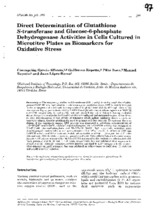Direct Determination of Glutathione S-transferase and Glucose-6-phosphate Dehydrogenase Activities in Cells Cultured in Microtitre Plates as Biomarkers for Oxidative Stress
Autor
García-Alfonso, Concepción
Repetto, Guillermo
Sanz, Pilar
Repetto, Manuel
López-Barea, Juan
Editor
Fund for the Replacement of Animals in Medical ExperimentsFecha
1998Materia
Molecular biomarkersOxidative stress
Direct in vitro assay
Glutathione transferase
METS:
Mostrar el registro METSPREMIS:
Mostrar el registro PREMISMetadatos
Mostrar el registro completo del ítemResumen
The enzymes glutathione S,-transferase (GST) and glucose-6-phosphate dehydrogenase
(G-6PDH) are implicated in the defence against oxidative stress. GST is mainly involved
in the conjugation of electrophilic compounds with glutathione (GSH), although some of its
isoenzymes display peroxidase activity. G-6PDH and glutathione reductase regenerate NADPH
and GSH, respectively, to restore the reduced intracellular redox .status following oxidative
stress. Enzymatic assays for GST and G-6PDH were adapted and optimised to permit the direct
in vitro determination of the effects of toxicants which induce oxidative stress in cells on
microtitre plates, thereby avoiding the need to prepare cell-free extracts. To optimise the conditions
of the enzymatic assays, GST activity was measured at substrate concentrations of
1-3mM GSH and 1-3mM 1-chloro-2,4-dinitrobenzenew, hile G-6PDH activity was measured at
7.5-37.5mM glucose-6-phosphate and 55-275mM NADP. Both enzymatic activities were
directly proportional to cell number up to a density of 1 x 105 cellsiwell. The effects on GST and
G-6PDH activities of three toxicants which induce oxidative stress - paraquat, iron (11) chloride
and iron (111) chloride - were compared in cultured Vero cells to validate the new assays.
Specific GST activity increased to 145% and 171% compared to the controls in cells treated with
5mM paraquat and 5mM iron (11) chloride, respectively, but was inhibited after exposure to
25mM iron (111) chloride. Specific G-6PDH activity increased to 136% compared to the control
after exposure to 5mM paraquat, but was inhibited in cells exposed to 5mM iron (11) chloride
and 25mM iron (111) chloride

